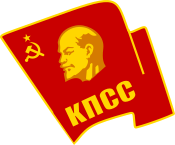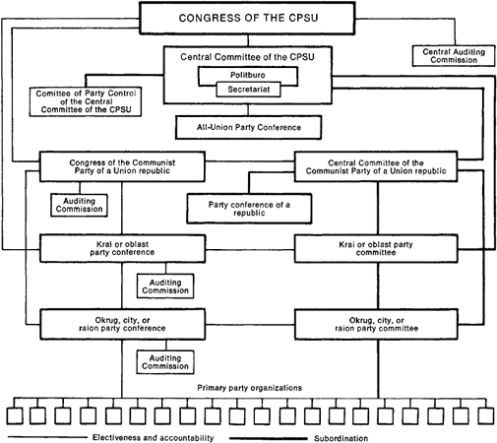More languages
More actions
Communist Party of the Soviet Union Коммунисти́ческая па́ртия Сове́тского Сою́за | |
|---|---|
 | |
| Abbreviation | CPSU |
| Founded | May, 1917 |
| Banned | 6 November 1917 |
| Dissolved | 6 November, 1991 |
| Newspaper | Pravda |
| Think tank | Central Policy Research Office |
| Youth wing | Young Communist League Vladimir Lenin All-Union Pioneer Organization |
| Political orientation | Marxism–Leninism |
| Part of a series on |
| Communist parties |
|---|

The Communist Party of the Soviet Union (CPSU),[a] was a communist party tracing back to the Russian Social Democratic Labor Party (RSDLP), which was established in its second congress in 1903.[1] The party brought together the vanguard of the Soviet peoples in the construction of socialist society.
Its predecessor, the RSDLP, had split into Bolshevik and Menshevik factions in 1903. The CPSU emerged in continuity with the Bolshevik political line.
The Bolsheviks changed their name to the Communist Party of Russia (Bolsheviks) in 1918, the All-Union Communist Party (Bolsheviks) in 1925, and the Communist Party of the Soviet Union (Communist Party of the Soviet Union) in 1952.
Names[edit | edit source]
History[edit | edit source]
Russian Social Democratic Labour Party[edit | edit source]
In 1898 the Russian Social Democratic Labor Party was created, uniting the several communist study groups scattered around Russia. Among its founders were people like Vladimir Lenin and Julius Martov. It established itself as a Marxist party that had the task of overthrowing the monarchy and bring about socialism. However during the course of the struggle there was a lot of disagreement about when this goal was to be implemented and how. In 1903 emerged a de facto split in the party, and two factions were formed: the Mensheviks led by Martov and the Bolsheviks led by Lenin.
Although Lenin and many others first anticipated the two groups could merge again, the split ended up worsening and the two factions became separate parties: the Russian Social-Democratic Labour Party (Mensheviks) and the Russian Social-Democratic Labour Party (Bolsheviks).
The main differences between the groups were the following:
1. The Bolsheviks wanted an organisationally united party of serious revolutionaries while the Mensheviks wanted a more loose reformist party.
2. Both parties agreed that the next course of action was to overthrow the monarchy and carry out the so-called “bourgeois-democratic revolution.” This would make Russia a capitalist parliamentary democracy. However the Mensheviks argued that the class to lead the revolution was the bourgeoisie, the capitalist class, as the bourgeois class served this function in the French Revolution. The Bolsheviks disagreed, they thought the capitalists couldn’t be trusted to carry out the democratic revolution: they were weaker than the bourgeoisie in France at the time, they allied with the monarchy, and they feared the workers and peasants. In fact, Lenin argued that the Russian proletariat was much stronger and more developed than the French proletariat of the late 1700s and therefore should lead the democratic revolution, and not merely support it.
3. Lastly, the Mensheviks didn’t think Russia was ready for socialism, in their opinion the workers could never take power in Russia until after a long time of capitalist and parliamentary development. Even though the debate about workers revolution and socialism would only come about fully later, this attitude relates to the Menshevik position that the workers shouldn’t lead the democratic revolution, but only support the capitalist class against the monarchy.
In the 1907 London Congress (the Fifth Congress of the RSDLP) for example, the Mensheviks advocated for a liquidationist program that would see the RSDLP dissolved in favor of a Bourgeois democratic 'Labor Congress', branding the RSDLP a 'petty bourgeois intellectual' organization. This was in stark contrast to the member compositions of the pro-Party group (Bolsheviks) and anti-Party group (Mensheviks), where the Bolsheviks in percentage and in total numbers possessed a higher degree of Proletarian elements as opposed to the Mensheviks' petty bourgeois composition. The blatant fabrication and liqudationist line advocated by the Mensheviks was opposed by even their own Proletarian elements and denounced as Opportunist by Rosa Luxembourg, a visiting delegate of the SPD. [2]
Split with Mensheviks[edit | edit source]
October Revolution[edit | edit source]
The party grew from 10,000 members in April 1917 to 500,000 by the time of the October Revolution.[3]
Civil War[edit | edit source]
The party reached 600,000 members in 1921. Lenin conducted the first purge of the party in 1921 and expelled 25% of its members including 45% in the countryside. This purge was the largest in the party's history. Party members could be expelled for the following reasons:
- Being former kulaks, Whites, or counterrevolutionaries
- Being corrupt, bureaucratic, or overly ambitious
- Rejecting party discipline or disobeying the Central Committee
- Committing crimes or sexual misconduct or being drunk publicly[4]
Internal struggles[edit | edit source]
Trotsky and Zinoviev formed an anti-Party bloc in 1926, leading the Central Committee to organize a general party discussion. 724,000 party members voted for the Central Committee and only 4,000 or less voted for the Trotskyists.[5]
The Central Committee purged Trotsky and his followers from the party in December 1927. In June 1928, several Trotskyists, including Zinoviev, Kamenev, Preobrazhensky, and Rykov, returned to the party after recanting their views. Bukharin and the Right Opposition soon formed an alliance with the Trotskyists against Stalin.[6]
Between 1928 and 1931, the CPSU accepted 1.4 million new members, including many who lacked theoretical knowledge. 11% of the party was purged in 1929. Another purge began in 1933 and lasted two years. It was difficult to tell who was a party member because 250,000 party cards were lost or stolen.[4] Zinoviev and Kamenev were purged a second time in the early 1930s.[6]
17th Congress[edit | edit source]
The 17th Party Congress was held in 1934 following the success of the First Five-Year Plan. Opposition leaders were invited to make speeches.[6]
1937–38 purges[edit | edit source]
278,818 people were expelled from the party during the purges of 1937 and 1938. The number of expulsions was lower than in previous years, but a much higher proportion of those purged were active cadres. Many wrongfully purged members appealed to rejoin the party, and 54% them were readmitted. Out of 182,000 Old Bolsheviks (party members before 1921) in 1934, 125,000 remained in the party by 1939.[7]
19th Congress[edit | edit source]
At the 19th Party Congress in 1952, the last congress before the death of Stalin, Malenkov upheld Marxism–Leninism, self-criticism, and party discipline. Stalin criticized Mikoyan and Beria and worried that the party would not be able to recognize enemies without him.[8]
Perestroika[edit | edit source]
The CPSU held its 19th Conference in June 1988, and Gorbachev and Yakovlev implemented parliamentary policies. Gorbachev purged non-revisionists, including Andrei Gromyko, from the Politburo, and changed Ligachyov from head of ideology to head of agriculture. Party membership began dropping, and the party lost more than 250,000 members in 1990.
The 28th Party Congress in July 1990 weakened the Central Committee and made the entire Congress instead of just the CC elect the General Secretary. It allowed the formation of factions within the party.[9]
Demographics[edit | edit source]
In 1922, Jews made up 5.2% of party membership, roughly five times their total proportion of the population. From the late 1920s through the 1940s, the percentage of Jews in the party was about 4.3%.[10]
In 1972, the majority of CPSU members were Russians, but Georgians made up the highest ratio of party members per capita, followed by Russians and then Armenians. Moldovans were the most underrepresented nationality in the party.[11] The percentage of women in the party rose from 7.4% in 1920 to 26.5% in 1981.[12]
References[edit | edit source]
- ↑ “Notwithstanding the fact that the First Congress of the Russian Social-Democratic Party had been held in 1898, and that it had announced the formation of the Party, no real party was as yet created. There was no party program or party rules. The Central Committee of the Party elected at the First Congress was arrested and never replaced, for there was nobody to replace it. Worse still, the ideological confusion and lack of organizational cohesion of the Party became even more marked after the First Congress.
[...]
Iskra linked up the scattered Social-Democratic circles and groups and prepared the way for the convocation of the Second Party Congress. At the Second Congress, held in 1903, the Russian Social-Democratic Labour Party was formed, a Party Program and Rules were adopted, and the central leading organs of the Party were set up.”
Joseph Stalin (1938). History of the Communist Party of the Soviet Union (Bolsheviks): 'Formation of the Russian Social-Democratic Labour Party. Appearance of the Bolshevik and the Menshevik groups within the party'. Moscow. - ↑ “Expressing her complete agreement with the Bolsheviks on the questions of the role of the proletariat as the leader of the revolution, the role of the liberal bourgeoisie as an anti-revolutionary force, etc., etc., Rosa Luxemburg criticised the Menshevik leaders Plekhanov and Axelrod, called them opportunists”
Joseph Stalin (1907-06-20 / 1907-07-10). "The London Congress of the Russian Social-Democratic Labour Party" Bakinsky Proletary. Retrieved 2024-03-03. - ↑ Vijay Prashad (2017). Red Star over the Third World: 'Red October' (p. 28). [PDF] New Delhi: LeftWord Books.
- ↑ 4.0 4.1 Ludo Martens (1996). Another View of Stalin: 'The struggle against bureaucracy' (pp. 102–105). [PDF] Editions EPO. ISBN 9782872620814
- ↑ “In October 1927, that is, two months before the Fifteenth Congress, the Central Committee of the Party announced a general Party discussion, and the fight began. Its result was truly lamentable for the bloc of Trotskyites and Zinovievites: 724,000 Party members voted for the policy of the Central Committee; 4,000, or less than one per cent, for the bloc of Trotskyites and Zinovievites.”
Joseph Stalin (1938). History of the Communist Party of the Soviet Union (Bolsheviks): 'The Bolshevik Party in the Struggle for the Socialist Industrialization of the Country'. Moscow: Foreign Languages Publishing House. - ↑ 6.0 6.1 6.2 Ludo Martens (1996). Another View of Stalin: 'The Great Purge' (pp. 116–117). [PDF] Editions EPO. ISBN 9782872620814
- ↑ Ludo Martens (1996). Another View of Stalin: 'The Great Purge' (pp. 167–170). [PDF] Editions EPO. ISBN 9782872620814
- ↑ Ludo Martens (1996). Another View of Stalin: 'From Stalin to Khrushchev' (pp. 253–260). [PDF] Editions EPO. ISBN 9782872620814
- ↑ Roger Keeran, Thomas Kenny (2010). Socialism Betrayed: Behind the Collapse of the Soviet Union: 'Crisis and Collapse, 1989-91' (pp. 180–187). [PDF] iUniverse.com. ISBN 9781450241717
- ↑ Albert Szymanski (1984). Human Rights in the Soviet Union: 'The European Nationalities in the USSR' (p. 88). [PDF] London: Zed Books Ltd. ISBN 0862320186 [LG]
- ↑ Albert Szymanski (1984). Human Rights in the Soviet Union: 'The Asian Nationalities in the USSR' (p. 59). London.
- ↑ Albert Szymanski (1984). Human Rights in the Soviet Union: 'Women in the USSR' (p. 118). London.
